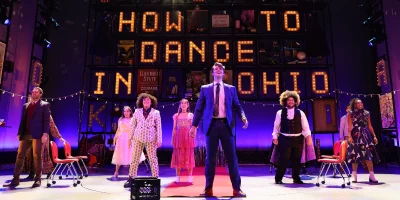
‘How to Dance in Ohio’ pioneers a more accessible Broadway
The musical, based on a documentary about autistic young adults, employs neurodivergent people on and off stage to ensure accurate, thoughtful representation.
How to Dance in Ohio could be called How to Make History in New York. The new musical is one of the first Broadway shows to put the experiences of autistic people at the forefront, on and off stage – and its team hopes it won't be the last.
Based on Alexandra Shiva's award-winning documentary of the same name, How to Dance in Ohio follows the stories of autistic, young adults preparing for a formal dance at their group counseling center. In the process, they reach major social milestones: making friends, talking to a crush, or just talking to people at all.
How does a team tell this story with accuracy and care? Neither director Sammi Cannold nor writers Jacob Yandura (music) and Rebekah Greer Melocik (book and lyrics) are autistic, so they hired autistic creative consultant Ava Xiao-Lin Rigelhaupt, now the first person to hold that title on Broadway.
"I'm on the autism spectrum, so I was brought on, with my history of script consulting, to help create authentic autistic characters," Rigelhaupt said. "I'm here to help the team understand autism and to think about access from the forefront, instead of access as an afterthought."
One of her initiatives, alongside community engagement director Becky Leifman, was sending out a pre-rehearsal accessibility survey. It resonated with the whole company: "Our Broadway vets said some of these questions, like 'What do you need to do your best work?,' had never been asked [to them] before," Rigelhaupt said.
Another rarity for Broadway, though, is that Ohio marks more Broadway debuts than not. Cannold, Yandura, Melocik, and choreographer Mayte Natalio, are all making theirs, as is the entire principal cast. The show includes neurodivergent and neurotypical characters, so authentic casting was key.
"It was a given to us from the get-go that the seven autistic characters in the show would be played by seven autistic actors," director Cannold said. "We did a nationwide search during the pandemic online [...] And off those videos, we cast seven individuals, and they are the seven individuals you're seeing here today, two years later."
In their Broadway debuts with How to Dance in Ohio, they become not just the next generation of Broadway, but pioneers of a more inclusive, accessible Broadway.
"There's been a lot of portrayals of autism in the past that weren't as great — they probably were back then, but not right now," said actor Conor Tague. "But autistic people playing autistic characters is growing. It's the thing that everyone needs right now, and we're proud to be part of that."
And there's still room to grow. As Cannold pointed out: "There's a saying that we start our show with: If you've met one autistic individual, you've met one autistic individual. It manifests very differently for everybody."
The team acknowledged that Ohio is not an entirely comprehensive representation of autism — for example, Ohio's characters and actors use disability-first language to refer to themselves ("autistic person") as opposed their real-life counterparts, who use person-first language ("person with autism"). Additionally, none of the autistic characters are nonverbal, which led to "hard conversations" with those members of the community, Melocik recalled.
"We have to keep pushing for communication rights for all," Melocik said. "It's an honor to be able to have this conversation in front of people, honestly, and I hope we keep pushing them further."
They already are. According to Melocik, the creative team keeps notes on their process and feedback from the autistic artists in the room. They plan to compile it into a "living author's note document," allowing for changes so any person, autistic and not, can feel welcomed and represented in future productions of Ohio.
Or as Rigelhaupt put it, "It's not just about being invited to the party. It's being asked to dance."
Photo credit: The world premiere of How to Dance in Ohio at Syracuse Stage in 2022. (Photo by Curtis Brown)
Frequently asked questions
What is How to Dance in Ohio on Broadway about?
Dance and sing for the musical adaptation of Alexandra Shiva's Peabody Award-winning documentary of the same name. Go along with seven autistic adults as they prepare for a spring formal dance — and in the process, find new courage and confidence as they change up their everyday lives.
Where is How to Dance in Ohio on Broadway playing?
How to Dance in Ohio on Broadway is playing at Belasco Theatre. The theatre is located at 111 West 44th Street, New York, 10036.
How long is How to Dance in Ohio on Broadway?
The running time of How to Dance in Ohio on Broadway is 2h 20m (Incl. 15m Intermission)
What's the age requirement for How to Dance in Ohio on Broadway?
The recommended age for How to Dance in Ohio on Broadway is Recommended for 6+. Children under the age of 4 are not permitted in the theatre..
How do you book tickets for How to Dance in Ohio on Broadway?
Book tickets for How to Dance in Ohio on Broadway on New York Theatre Guide.
What are the songs in How to Dance in Ohio?
Rebekah Greer Melocik and Jacob Yandura's original score for How to Dance in Ohio includes songs titled "Building Momentum," "So Much in Common," "Under Control," and "Getting Ready for the Dance."
Who wrote How to Dance in Ohio?
How to Dance in Ohio is written by Rebekah Greer Melocik (book and lyrics) and Jacob Yandura (music). They adapted the show from Alexandra Shiva's award-winning documentary of the same name, and Melocik and Yandura are making their Broadway debuts.
Who directed How to Dance in Ohio on Broadway?
Sammi Cannold directs How to Dance in Ohio on Broadway. She's directed acclaimed shows at renowned venues like Radio City Music Hall, Lincoln Center, and the Kennedy Center, and she now makes her Broadway debut. Alexandra Shiva directed the original documentary the musical is based on.
Is How to Dance in Ohio appropriate for kids?
How to Dance in Ohio is suitable for children 6 and older. Please note that children 4 and younger are not permitted in Broadway theatres.
Is How to Dance in Ohio good?
How to Dance in Ohio is an original new musical that thoughtfully explores the lives and coming of age of autistic people. The show is uplifting, inspiring, and celebratory.
Originally published on



